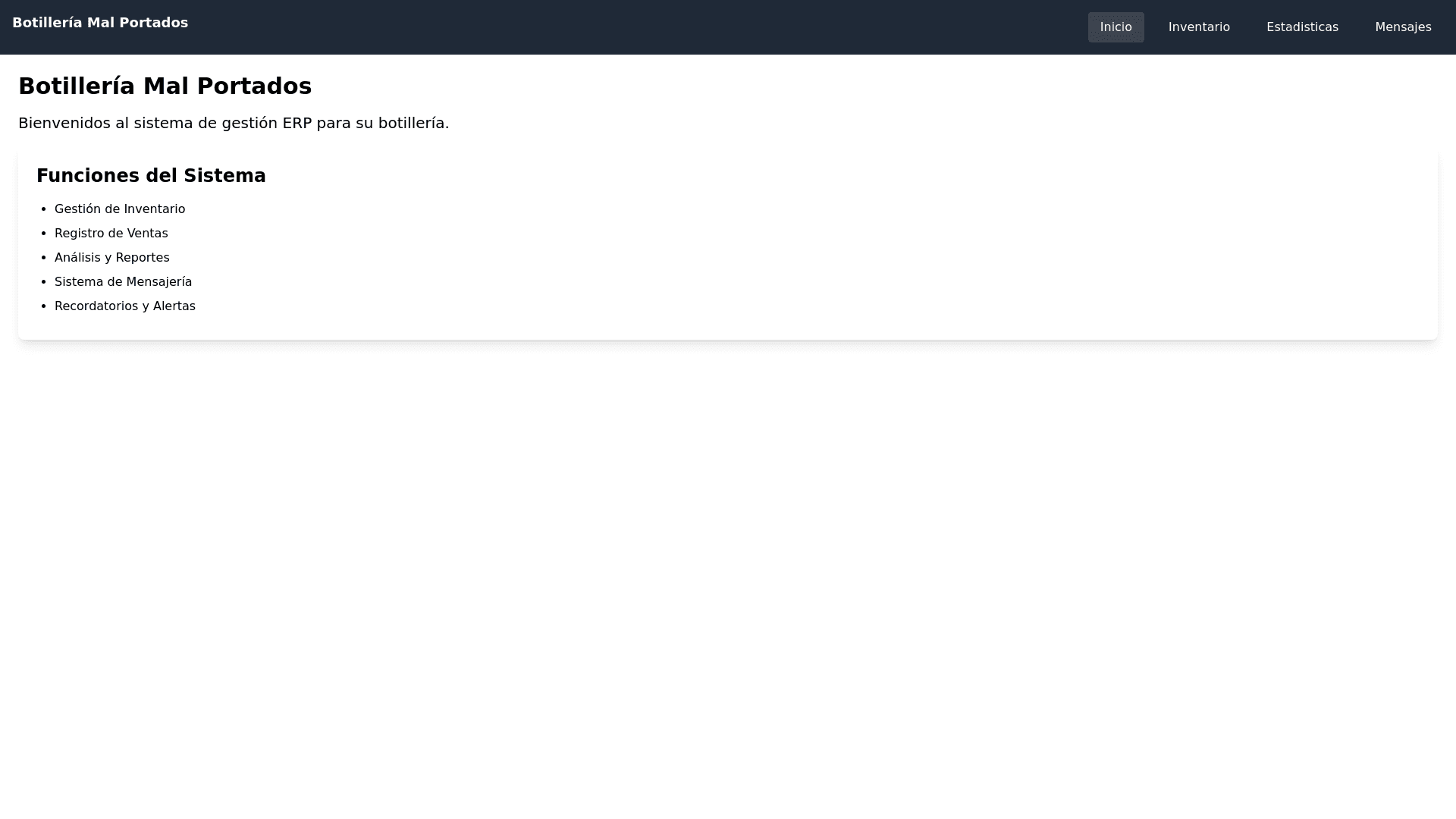E R P V.2 - Copy this React, Tailwind Component to your project
Develop an ERP system application for "Botillería Mal Portados" with the following features: ### **1. Main Menu** The program should include a main menu with the following sections: #### **Home** Display the application name: **"Botillería Mal Portados"**. A welcome message: **"Welcome to the ERP management system for the liquor store."** A brief explanation of the system's functionalities. #### **Inventory** **Product Table**: Show a table with the current products, including: Name, Category, Stock Quantity, Price, Last Sale Date. **Buttons for Interaction**: **Move to Inactive**: Transfers products to the inactive section. **Delete Product**: Removes the product from the inventory. **Add New Products**: Include fields to add new products: Name, Category, Initial Stock, and Price. #### **Inactive Products** List products that: Have not been sold in over 60 days. Were manually sent to inactive status from the inventory. **Options for Interaction**: **Reactivate Products**: Move products back to active inventory. **Delete Products**: Permanently remove products from the system. #### **Sales** Allow the user to register sales: Select a product, input the quantity sold, and date of the sale. Automatically reduce stock after registering a sale. **Sales Table**: Display a list of registered sales. #### **Alerts** Show alerts for: **Low Stock**: Products with fewer than 20 units in stock. **Inactive Products**: Products without sales for more than 60 days. **Options for Interaction**: **Move to Inactive**: Send the product to the inactive list. **Delete Product**: Remove the product entirely. #### **Statistics** Include interactive graphs: **Monthly Sales by Category (Line Chart)**. **Sales Distribution by Category (Pie Chart)**. **Current Stock by Category (Bar Chart)**. **Mathematical Formulas**: Display the formulas used (e.g., stock calculations, ROI, sales averages) under the graphs. **Formula Descriptions**: Explain the formulas and how they are applied in the program. #### **Predictions** Generate predictions based on historical sales patterns: Example: "Christmas is approaching: Stock 200 units of aguardiente." Example: "Holy Week: Increase inventory with 100 extra units of red wine." Provide **recommendations** to prepare for future demand. #### **Messages** A communication platform between the store administrator and suppliers: Include a field to write messages with a **send button**. Display messages with examples: "Supplier A: Delivery delayed for the beer batch." "Administrator: Requesting a new batch of premium wines." #### **Reminders** A list of important reminders with examples: "Replace broken store lights." "Restock cigarettes." "Contact the supplier for Austral beers." ### **2. Example Products and Data** #### **Main Categories**: Beers, Wines, Liquors, Snacks, Cigarettes, Non Alcoholic Beverages. #### **Example Products**: **Beers**: Cristal, Escudo, Heineken, Corona, Budweiser, Becker, Austral, Kunstmann, Baltica. **Wines**: Gato Negro, Casillero del Diablo, Santa Rita, Montes, Tarapacá, Cousiño Macul. **Liquors**: Pisco Capel, Ron Bacardí, Vodka Absolut, Whisky Johnnie Walker. **Snacks and Cigarettes**: Lays Chips, Marlboro, Lucky Strike. **Non Alcoholic Beverages**: Coca Cola, Sprite, Red Bull, Cachantún. ### **3. Mathematical Features** #### **Formulas Used**: **Stock Calculation**: Formula: `Current Stock = Initial Stock Quantity Sold`. Context: Automatically updates stock after each sale. **Return on Investment (ROI)**: Formula: `ROI = (Net Profit / Investment Cost) x 100`. Context: Evaluates the profitability of investments in the store. **Sales Average**: Formula: `Average = Σ(Sales) / Number of Months`. Context: Identifies sales trends over time. #### **Additional Features**: Display these formulas under the statistics section. Provide real time calculations and updates based on user interactions. ### **4. Organizational Development Advice** Provide recommendations based on data analysis: Increase stock during high demand periods (e.g., Christmas, New Year). Maintain active communication with suppliers to avoid delays. Implement marketing strategies for less popular products. ### **5. Predictions Based on Data** Use historical data to predict future demands: Alert about key dates and stock requirements. Example: "Christmas: Anticipate a surge in aguardiente sales." Example: "New Year: Higher demand for beers and sparkling wines." ### **6. Interactive Design** Well defined menus: Home, Inventory, Inactives, Sales, Alerts, Statistics, Predictions, Messages, and Reminders. User friendly design: Include visually appealing buttons with icons. Enable seamless navigation across sections. Real time updates for sales, inventory, and predictions.
